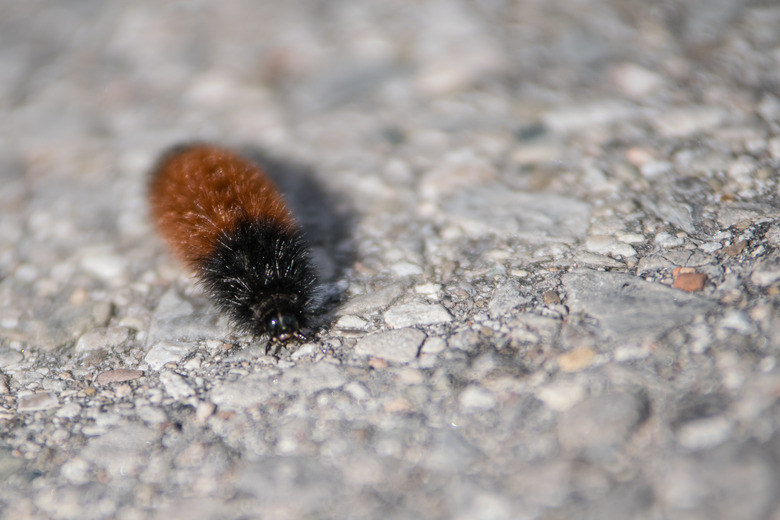Types Of Woolly Caterpillars
Woolly caterpillars are the larval stage of some species of moths. They are often seen in late summer and autumn, which they spend eating their fill of leaves and other vegetation to prepare the next stage of development. The larvae construct a cocoon in which they remain encased as pupae until they are ready to emerge as adult moths. Woolly caterpillars, also called woolly worms, are named for the stiff, hair-like bristles that cover their body.
Fuzzy Caterpillars: Looks Are Deceiving
Fuzzy Caterpillars: Looks Are Deceiving
Woolly caterpillars are often collectively called woolly bears due to their fuzzy, furry appearance. However, the hairs are not soft like fur. Their hairy – and sometimes spiky – body coverings may be a defense mechanism to deter predators that don't care to eat prey with a sharp-looking, bristly texture. Woolly caterpillars generally aren't poisonous or toxic to humans, but their bristles can cause skin irritation for people who touch them. They don't sting or have venom, but the bristles can cause a stinging sensation if they penetrate the skin.
Woolly Bears
Woolly Bears
The fuzzy caterpillar of the Isabella tiger moth is best known as a woolly bear. This black and orange caterpillar is also called a banded woolly bear because it is black at either end with a band of orange or reddish brown around the middle. Newly hatched woolly bears are all black. The orange band appears as they grow, and it grows wider as the caterpillar progresses through the larval stage of development. Woolly bear caterpillar food includes flowers, grasses and the leaves of flowering plants such as clover. They feed heavily in the fall as they prepare for winter.
American Dagger Moth
American Dagger Moth
The caterpillars of the American dagger moth are white with a few longer black "hairs" sticking out. They are sometimes called white woolly bears or white woolly worms, even though younger caterpillars are often yellow. They feed on leaves of several types of trees in the wet forests of eastern North America. After they finish feeding on a leaf, they hide the evidence of their feast by cutting off the stem from the twig so that it falls to the ground. This may prevent birds from spotting the white woolly bears due to their feeding activity.
Yellow-Spotted Tussock Moth
Yellow-Spotted Tussock Moth
The yellow-spotted tussock moth is sometimes called a yellow tiger moth because of the markings on the adult's wings. A tussock is a tuft of grass that is longer than the grass around it and is an apt descriptor for this caterpillar. Bunches of longer spikes project out of both ends of its body. It is yellow with a row of black spots down its back and sis ometimes black at each end. It lives in moist woodlands in the eastern U.S. and Canada and feeds on oak, maple, poplar and basswood leaves.
Virginia Tiger Moth
Virginia Tiger Moth
The caterpillar of the Virginia tiger moth is often called a yellow woolly bear. Its yellow fuzz ranges in color from cream to caramel and has longer hairs interspersed throughout the shorter hairs. Yellow woolly bears aren't tree dwellers like some other fuzzy caterpillars, but instead live close to the ground and feed on shrubs and flowering plants. They are found throughout the continental U.S.
Hickory Tussock Moth
Hickory Tussock Moth
Sometimes called a white woolly bear caterpillar, or white woolly, the hickory tussock moth caterpillar is white with a black line going down its back. Some individuals appear to have tiny black spots instead of a stripe. It lives in Canada and the eastern U.S. and favors a diet of oak, maple, walnut and ash leaves. Like the yellow-spotted tussock caterpillar, the white woolly worm sports clusters of longer bristles that stick out, in either black or white. The hickory tussock caterpillar has been wrongly identified in news reports as being poisonous. Typically, the worst reaction from touching one of these woollies is a skin rash.
Giant Leopard Moth
Giant Leopard Moth
This fuzzy caterpillar has shiny black bristles and grows to 3 inches in length. The adult moth is the largest of the eastern tiger moths. It ranges from southeastern Canada to Florida and feeds on the petals and leaves of a wide variety of flowering plants such as violets, dandelions and sunflowers.
References
Cite This Article
MLA
Mentzer, A.P.. "Types Of Woolly Caterpillars" sciencing.com, https://www.sciencing.com/types-woolly-caterpillars-8290779/. 22 November 2019.
APA
Mentzer, A.P.. (2019, November 22). Types Of Woolly Caterpillars. sciencing.com. Retrieved from https://www.sciencing.com/types-woolly-caterpillars-8290779/
Chicago
Mentzer, A.P.. Types Of Woolly Caterpillars last modified March 24, 2022. https://www.sciencing.com/types-woolly-caterpillars-8290779/
